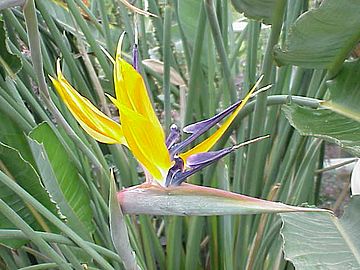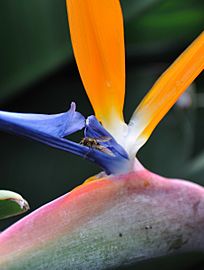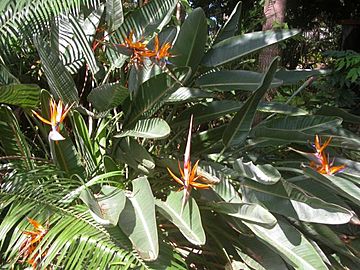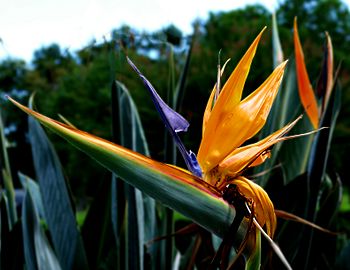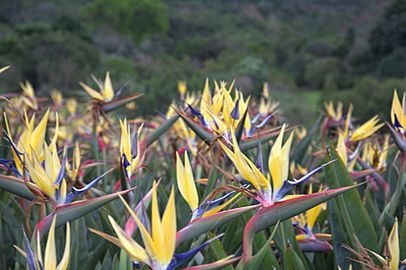Crane flower facts for kids
Quick facts for kids Crane flower |
|
|---|---|
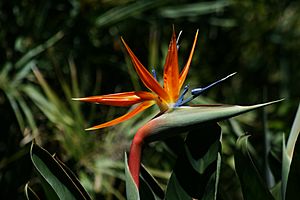 |
|
| Flower | |
| Scientific classification | |
| Genus: |
Strelitzia
|
| Species: |
reginae
|
The Strelitzia reginae, often called the crane flower or bird of paradise, is a beautiful flowering plant. It comes from South Africa and is also known as isigude in the Nguni language. This plant is an evergreen perennial, meaning it stays green all year and lives for many years. People around the world love to grow it because of its amazing, colorful flowers. In places with cooler weather, it's a popular plant to keep indoors.
Contents
About the Bird of Paradise Flower
The Bird of Paradise flower got its scientific name, Strelitzia reginae, in 1788 from a scientist named Joseph Banks. The word reginae means "of the queen" in Latin. It was named to honor Queen Charlotte of Mecklenburg-Strelitz, who was the wife of King George III of Britain. The common names, "crane flower" and "bird of paradise," come from how the open flower looks a lot like the head and beak of a colorful, exotic bird.
In 2002, a new type of this plant was found near the Mzimvubu River in South Africa. When these new plants grew flowers, they had white inner petals instead of the usual blue ones. They also had a shorter part called a stigma. This new type is now called Strelitzia reginae subsp. mzimvubuensis.
What the Plant Looks Like
This plant can grow up to about 2 meters (6.5 feet) tall. It has big, strong leaves that are about 25 to 70 centimeters (10 to 28 inches) long and 10 to 30 centimeters (4 to 12 inches) wide. These leaves grow on long stems called petioles, which can be up to 1 meter (39 inches) long. The leaves are always green and grow in two rows, making the plant look like a fan.
The amazing flowers grow on tall stalks that stand above the leaves. Each flower comes out of a hard, beak-shaped cover called a spathe. This spathe sticks out straight from the stem, making it look exactly like a bird's head and beak. It's also a strong place for sunbirds to sit when they visit the flower.
The flowers have three orange sepals (which look like petals) and three petals that are either purplish-blue or white. Two of the petals are joined together to form a special part that holds nectar. When sunbirds land to drink the nectar, the third petal opens up. This releases pollen and covers the bird's feet, helping the plant with pollination.
Growing and Using the Plant
The Strelitzia reginae is very popular as an ornamental plant, which means people grow it just for its beauty. It was first brought to Britain in 1773 and grown at the Royal Botanic Gardens, Kew. Since then, it has spread all over the world, including North and South America and Australia. It grows best in sunny and warm places. In the United States, it's very common in warm areas like Florida and California. The City of Los Angeles even chose it as its Official Flower!
In places where winters are cold, people usually grow the Bird of Paradise flower indoors in a sunny spot, like a greenhouse. This is because it doesn't like cold weather or frost. However, you can move it outside during the warmer summer months. This plant has even won an award called the Royal Horticultural Society's Award of Garden Merit because it's such a great plant to grow.
It's a plant that doesn't need a lot of special care. It can grow in different types of soil and doesn't need much water once it's settled. If you take good care of it, it can flower several times a year. It likes rich soil and plenty of water. It also does well in full sun or partial shade and likes to be fed regularly with plant food and compost. Remember, it needs to be protected from frost, as cold can harm its flowers and leaves.
New Bird of Paradise plants can be grown from seeds or by dividing an existing plant. Plants grown from seeds take a while to bloom, usually three to five years. The flowers, once they appear, last for a long time. They usually bloom most in winter and early spring. There's also a special type of this plant with yellow flowers called ‘Mandela's Gold’.
Allergies
Good news for people with allergies! Bird of Paradise plants are considered "allergy-friendly." They don't release pollen into the air, so they are unlikely to cause allergic reactions.
Gallery
-
Kolkata, India


